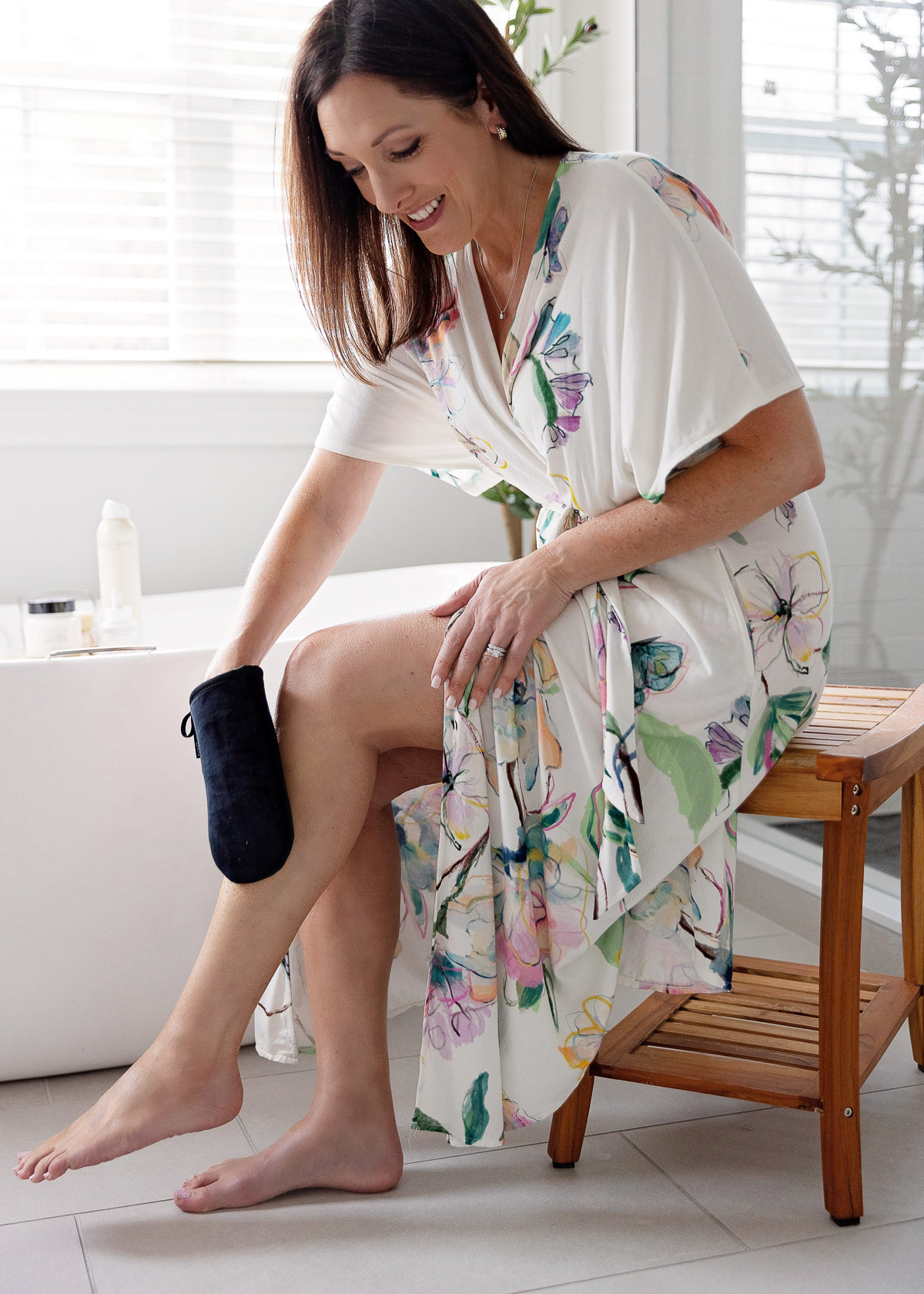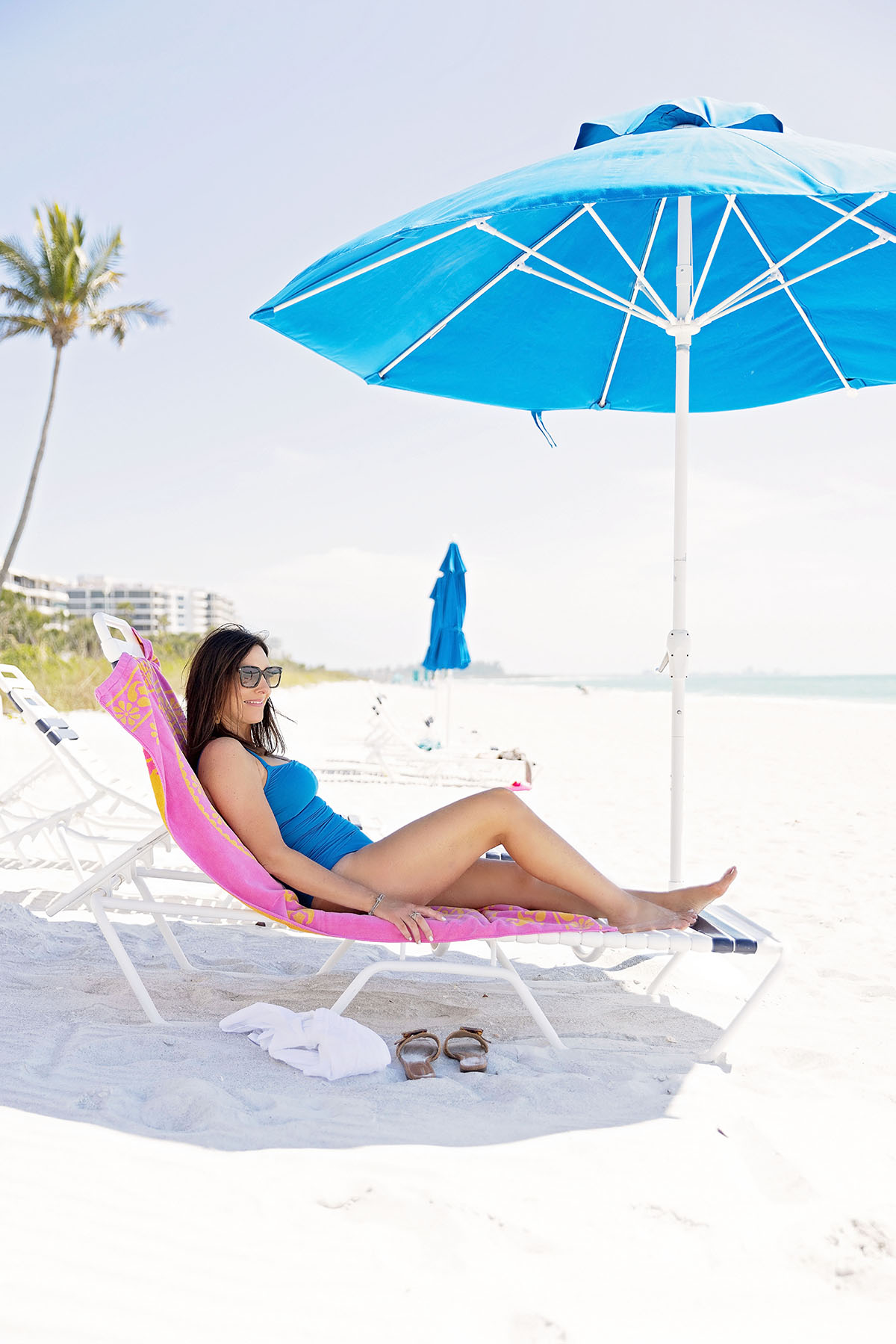It’s been two years since I wrote this post about the potential dangers of chemical sunscreens so I decided it was time for a reprise. The sad thing is, we all thought we were doing the right thing by slathering our kids with sunscreen every day, but it turns out, we could be causing far more harm than the sun that we’ve been taught to fear.
Don’t get me wrong; I am not cavalier about the sun. There is melanoma on both sides of my family so I take this issue very seriously. But it seems as if not all sunscreens are created equal. In a recent post, Katie explains very succinctly in this post how chemical sunscreens can react with the sun to possibly increase the risk of certain cancers. (When I say “chemical sunscreens” I am talking about most of what you find on the shelves at your typical drugstore. The alternative are mineral sunscreens, made with zinc oxide or titanium dioxide, which do not penetrate the surface of the skin; however “they say” that it is important to choose those that do not use nano-particles.) {source}
I know. Why does everything have to be so complicated??
My current fave is Eco-logical. It scores a 1 (least toxic) by the EWG (Best Sport and Beach Sunscreens) and it goes on pretty smoothly. We also use Badger SPF 30 since I have some left from last year.
So with that preamble out of the way, here is the post as originally posted on July 11, 2011:

Last weekend as I was sitting by the pool at the Hyatt, the lady next to me started spraying a can of aerosol sunscreen all over herself, and me in the process. Because I have no unspoken thoughts, I grabbed my phone and tweeted something to the tune of, “Gawsh people. If you must spray yourself with chemical sun screen, can you at least try not to pollute the rest of us?”
That comment created quite a response in my Twitter stream, and I realized that most people just don’t know how harmful that stuff is. And who am I to judge? Just two summers ago, I was spraying that crap all over myself and everyone within a 50-ft radius too.
I’ve written about this before, although I didn’t really get into all the various aspects of the issue because it’s complex. But after the conversation on Twitter last week, I was prepared to come back and do some homework and write a post. Fortunately before I had the chance, Mandie did it for me. You must read Balancing the Risks of Sunscreen and Skin Cancer at Life Your Way. It is by far the most succinct and thorough post I have read on the topic of sunscreens/sunblocks/skin cancer.
I love how she starts out the article by saying that she could never buy into the hype that something as beautiful and necessary to life on earth as the sun could be inherently bad for us. I have always said that too! I love the sun. I love how it warms my skin and makes everything bright and happy. I couldn’t believe it was all bad, all the time, and I’ve never been one to slather myself from head to toe with sunscreen before I dare to venture outdoors.
Nowadays we know that the sun provides essential nutrients that strengthen our immune systems. We also know that without adequate sunlight, people often get depressed and end up with seasonal affective disorder. Um, have you talked to me long about February or March? I’m certifiable. We NEED sunlight.
We are also learning that there are potential dangers to using chemical-based sunscreens — like, you know, cancer. The thing that I find most disturbing about chemical-based sunscreens is that if you don’t reapply (and I have never been very good about reapplying throughout the day b/c we didn’t seem to need it to prevent burning), they can actually interact with sunshine and for a nice cancer cocktail of free radicals and oxidation. Nice, huh?
Fortunately there are better options, namely mineral based sunblocks that use zinc oxide or titanium dioxide as their primary active ingredients.
I’ve had a lot of people ask me what brands we use. I prefer to use nothing, but I’m not one to keep my kids inside during the mid-day hours, and let’s face it. We are pasty. So we do use sunblock more than I’d like. Mandie likes California Baby brand sunblock, and my doctor recommends the Badger brand. I have both and use them interchangeably. Cali Baby uses titanium dioxide, and Badger uses zinc oxide, which technically is supposed to be a little bit safer. Zinc is even safe for babies and is often used in diaper rash creams.
Last year Katie tested 28 mineral based sunblocks, and you can check out her article for more information. By the way, she makes a great point in her post about the word “natural” when associated with skincare products. Plenty of “natural” things are hazardous to our health. I try not to use that word although it’s tempting to fall into the habit. And don’t be deceived by products with an “all natural” label on the packaging — there are no official regulations for that term, neither with food or skincare products. In fact, usually it’s a big huge red flag, in my book. If it says “all natural” then most likely it has something in it that I don’t want.
I like to check out my products on the Skin Deep Cosmetics Database put out by the Environmental Working Group, which is supposedly a non-profit consumer advocacy organization. This is the same group that puts out the Dirty Dozen each year. Their 2011 Sunscreen Guide is a great resource, but again, not all products with a good rating are free of every potentially harmful ingredient. Some of their products rated a 2 contain parabens, so as always, read your labels.
One final note — I have noticed that I have to be diligent about re-applying mineral sunblocks when we’re going to be in the sun all day (like at the pool last week.) Because they don’t sink into the skin, when they wash off, they are no longer effective. I have to be more careful to use them than I did with the chemical ones.
Also, they do go on a bit thicker than the stuff you’re used to, and I’ll warn you — they aren’t cheap. It seems like nothing that’s good for you is. Okay, that was three final notes. So sue me.
In the end, nothing’s perfect, I guess. For now, we allow ourselves 10-15 minutes of sun exposure and then cover up with the mineral sunblocks or hide out in the shade. If you must be out all day without protective clothing, go for the mineral based sunblocks and rest easy knowing that you’ve done one more thing to reduce the chemical load on your family.








23 Responses
Thank you for the reminder! I need to stock up! I read Katie’s article last year and it was wonderful. We tried some great products and love them but I just hate having to order everything online, so I caved a few times last year when we were out of sunscreen. :/ We used “Mexitan” and “Carribean Solutions Sol Care” and were very happy. They stayed on at the beach through water and beach play without having to reapply. I have kids that tan easily and pasty white kids and they both fared well with these products. They are rather pricy but not that much more than others and you don’t need to use a lot at the time of application. Do you know if mineral sunscreens block Vitamin D absorption? I’ve started to just let the kids be outside for about 10 minutes before putting the sunscreen on them so that they can soak in some Vitamin D before I block everything! (just in case) It’s hard to do when you’re at the pool, so I just make sure we spend extra time outside getting ready and getting everything in the car. Easier to do at the beach because we have to walk there and set up before they run to the water. With 8 kids it takes us while to “set up.” 😉
This is a good reminder that I need to find something new for us. I have a little left over from last year, a zinc based, that worked well but it’s almost out. I’m pretty sure that one of my girls reacts to titanium as she once broke out all over the day after being smeared w/ some sunscreen with that base. I also found out this weekend that all of my children will break out when smeared with a traditional chemical sunscreen when I needed something quick and broke down and bought the pink bottle kind (you know, the one with the little girl and dog). I’d actually like to try and make some of our own, I’m pretty sure you can buy everything you need from the company that sells hard lotions (I’m blanking at the name right now). I’m thinking it might be a little cheaper and definitely has the fewest ingredients. So, thanks! You’re always good at reminding me what I need to remember!
EWG has a really neat app for when you’re at the store and trying to figure out what to get. It has come in handy for me many times when I’m trying to figure out which varieties rate low on the scale and which don’t. It was just updated for 2013 recently too.
That’s great to know, thanks!
I’ve always hated wearing sunscreen, thankfully I don’t burn easily and usually don’t have to use anything unless I’m spending an ENTIRE day at the pool or ocean. Good info on what to recommend to my fairer family members, and what to consider for my baby when she gets here!
Also, it is important to note that many Americans are deficient in vitamin D. Dermatologists are scaring people out of the sun. For years I have been extremely vigilant about wearing sunscreen, using hats and beach umbrellas, avoiding the sun during peak hrs. etc…I recently found that my D levels were below the optimal level. Vitamin D deficiency is linked to depression, joint pain, poor immunity and even some types of cancer. I have been supplementing with the vitamin and have noticed improvements in my mood and sleep. I will have my levels rechecked in 3 months. I’m still not sure how much actual sun exposure I need. I’ve read 15 min. three times a week is okay for most people, but I want to avoid sun spots and wrinkles, so I’m still not even getting that much sun exposure. You can do some research on the subject and see what’s safe for you. Hope this helps someone.
Absolutely! I have written about this before, and I am surprised I didn’t mention it here. My doctor recommends getting about 15 min of sun in the middle of the day BEFORE applying sunscreen – totally not what you’d expect to hear from a doctor, right?
Hmmm, I have mixed feelings on this post. I have worked in Dermatology Research at the VA Medical Center with the Chief of Dermatology for more than 15 years and preach regularly about sunscreen use. I am not aware of any true clinical research to support the whole “chemical sunscreens cause cancer” theory. Also, by stating that sunscreens may cause cancer could lead to people not using it all which puts you at a much higher risk of skin cancer. Also, a base tan is NOT protection from the sun. A base tan is sun damage. That fact is indisputable. I respect everyone’s opinion and to each his/her own.
Kim
Hi Kim. Thanks for your respectful comment. As I said above, I don’t take this subject lightly. My doctor (who is an MD who takes a holistic approach to healthcare) recommends moderate amonts of sun exposure for the vitamin D benefits and then using a mineral based sunscreen after that.
There are so many issues like this one, where the medical community disagrees, and I really wish there was more conclusive data. It’s so frustrating as a person who wants to do the best she can for her family but has no medical/science/analytical background to try to sort through it all. I confess that the more I learn, the more confused I get. For now, I’ll go with my doctor on this one, but I’m definitely open to hearing different view points so I appreciate your POV.
Kim,
I’m the gal who tested out the 28 (now 43 actually) sunscreens that Jo-Lynne linked to in this post, and I’ve written quite a bit on sunscreen. I hope you don’t mind me jumping in too.
I think you make a really good point about people ending up feeling almost afraid of sunscreen and then not putting it on enough and getting burned. Finding the balance between getting some sun exposure for the Vitamin D benefits and getting the sunscreen on is tricky, so I can even see that result in our own family sometimes. I hate that feeling of, “Arg, I waited too long to put on sunscreen and they’re looking pink!!” when I look at my kids (happened today in fact, sigh). I give myself the “bad mom award.”
I’m surprised to hear that you’ve never come across any research that sunscreen causes cancer. I feel like oxybenzone in particular is pretty well established as toxic. Heather Dessinger does even better research than I do generally – do you see anything substantiated over here: http://www.mommypotamus.com/many-healthy-sunscreens-accelerate-skin-aging/ or here: https://www.mommypotamus.com/wait-what-sunlight-prevents-cancer/ ?
I was just reading somewhere about how the production of melanin offers protection for the skin from the sun, i.e. the base tan theory. I wish I could remember exactly where.
Ultimately, I have a lot of questions about the theories that (a) sunlight causes cancer and (b) sunscreen prevents cancer. My neighbor and I were talking, and just common sense wise, why is it that so many people get their skin cancer in areas that aren’t really exposed to the sun (buttocks, for example) and plenty of people DON’T get skin cancer on places like their nose, even if, like my neighbor, they never wore sunscreen as a kid and got burned and peeling every summer, all summer long? I know that’s just anecdotal, but I’d love to hear the dermatology response, because I’m sure there’s information I just don’t understand about that.
The statistics on skin cancer have not really decreased as sunscreen use has increased, which I suppose could simply mean that a lot of people are now seeing the consequences of former poor sun exposure practices – is that the general dermatology theory? That it was too late for folks who damaged their skin long ago?
I’m curious – what active ingredients do you counsel patients to look for in sunscreen? And what is the best way to get our necessary Vitamin D from the sun? Are there certain times of day that are good or bad, can Vit D get through sunscreen at all, and how many minutes of sunlight do people need?
I’m not trying to be lippy or oppositional; I just really want to understand all the sides of the issue, and I think it’s wonderful that Jo-Lynne has a visitor with real clinical knowledge. Feel free to point me to journal articles demonstrating research that sunscreens prevent cancer, etc.
Thank you so much for your time and knowledge!
🙂 Katie Kimball
This is a controversial subject. I think is comes down to common sense and moderation. Obviously, too much sun exposure is a major problem, but too little may be also. Doctors do not seem to have a clear answer on the subject. Check out this link to learn more:
https://www.cbsnews.com/2100-3480_162-776320.html
thanks, Sharon, so that basically backs up what my doctor recommends, at least as far as the moderate sun exposure. of course, it doesn’t tackle the issue of the different types of sunscreen. I’d really like to see more on that issue. for now, I guess I’ll continue to break the bank on the mineral ones, lol.
Right, my dermatologist recommends a broad spectrum sunscreen with zinc oxide. Make sure it says broad spectrum or it won’t block out all UV rays. My esthetician suggested I use Obagi-C Sun Shield Broad Spectrum SPF 50. It has more zinc oxide than most at 10.5% but also seems to have some type of chemical block 🙁 If I do expose myself to the sun without protection (just long enough for some vit. D), I always put sunscreen on my face and wear a hat.
yes, I do my face too. I don’t want sun spots.
Sharon,
Just jumping in – I’m the gal who reviewed 28 mineral sunscreens (up to 43 now). 10.5% zinc oxide is actually pretty abysmal. Most I tested were up in the realm of 20% and more, so you got some bad advice there…
🙂 Katie
After reading this, I’m thinking about ordering Badger sunblock.
I do have a question for anyone who cares to answer…
One of my daughters is a red head with very fair skin. I have to send her to school with at least some sunblock under her eyes (that is where she burns the most). I usually use Neutrogena sunblock for faces only because all the other waterproof ones don’t fully disappear and make her face look chalky and awful. So my question is, do these chemical free sunblocks look OK on the face??
Badger is pretty hard to rub in. Eco-logical does okay on the face, though.
I’m a big fan of Episcencial’s Sunny Sunscreen. I guess it’s for “kids” but we all wear it. If we’re only going to be outside for 1/2 an hour, though, we definitely skip it and choose to soak up some much needed vitamin D! I save sunscreen for days we will be outside all day (beach, amusement park, etc).
I have a hard time trusting scientific advice from someone who apparently never learned that minerals are, in fact, chemicals.
The point is not to mince words, but that the synthetic chemicals work differently, by absorbing into the skin, than the physical blocking mineral chemicals, if I must describe them that way, which form a physical barrier on the surface of the skin, where the free radicals cause far less damage.
Katie
I spent all week working on an article about sunscreen for Babble. It’s shocking how convoluted the whole thing has become…kind of like food. Now that I’ve gotten to the bottom of it, I feel a little bit better and am glad there are good, mineral-based protection options. Sad that they’re less accessible and more expensive but the more dialogue we create, the more likely retailers will start carrying them and maybe that demand will bring the cost down. I linked to your eco recommendation. I haven’t tried that one but it’s on my list. My sons wear what I want them to but I have to find one for myself that I’m comfortable applying, although I don’t spend much time in the sun at all.
Great advice! I share the same philosophy. We all need to be out in the sunshine without sunscreen, even if it’s just for a few minutes. Like a nutrient packed meal, the sun holds tremendous healing power – and is an essential source of vitamin D. Thanks for sharing!
More fear and falsehoods from Katie at Kitchen Stewardship.
The dangerous base tan myth has been effectively time-and-time again, but here’s a simple debunking from the New York Times. It’s damage, not protection, and you don’t need to expose your kids to skin cancer for them to get enough vitamin D.